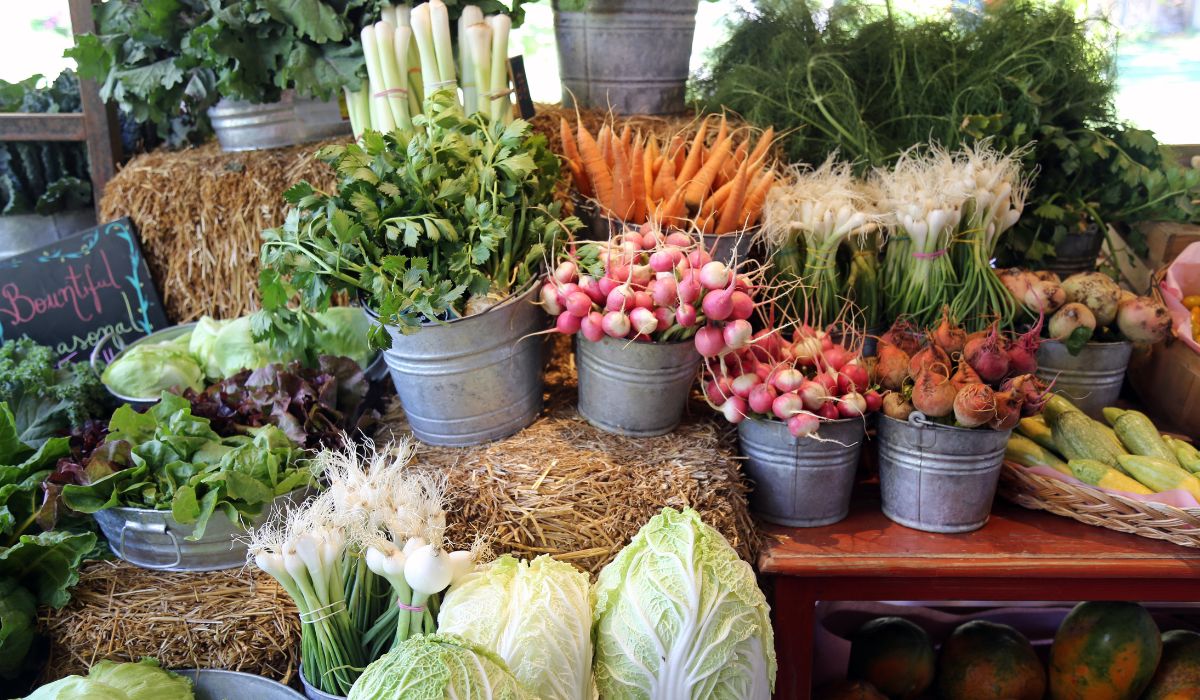Summer market season is starting up again, and a farmers market is a great place to get some fresh local produce…until you look at the asking price for everything and quail a little on the inside.
It’s true: farmers markets are expensive. You can say that’s just the real price of food once you take out all the subsidies and pay the workers fairly, you can say the nutrition justifies the cost, you can say the farmers deserve every cent they get (and you'd be right!), but the fact still remains: it’s expensive.
But there are ways to make it easier without stiffing any farmers - did you know you can actually get some of the health benefits of the market for free? Check out 6 tips for budget Paleo shopping from your local market.
1. Focus on Vegetables, not Fruit or Prepared Foods
At any given farmers market, you’ll find a whole mix of stuff – raw fruits and vegetables, fresh cut flowers, homemade spice blends, fresh bread, prepared foods, tea, local honey and maple syrup, local handicrafts…
If you’re strapped for cash, go for the fresh raw food first – and if you want the most nutritional bang for your buck, focus on the vegetables. In most places, vegetables are cheaper than fruit (although your market may be an exception depending on where you live!) and vegetables also have a higher nutritional value than fruit, so you’re getting a lot more value for money.
Of course, there’s a time and a place to splurge on perfect ripe peaches or late-summer raspberries. But if you’re working on a shoestring budget, let those be treats and not staple foods that you stock up on every week to fill the pantry.
2. Ask for Ugly Produce

Depending on where you live and how squeamish your neighbors are about vegetables that don’t look pretty, the farmers at your market might very well have a bunch of ugly produce – it’s just as nutritious and tastes perfectly fine, but it looks a little weird so it’s hard to sell. Think carrots with a random extra spur sticking out of them, or apples that are kind of weird and lumpy instead of nice and spherical.
Some farmers will happily give you a discount on produce that’s cosmetically ugly but has no other flaws. But remember: the whole point of the market is to have a human relationship with the farmer; be respectful when you ask, and be appreciative if the answer is yes.
3. You Don’t Have to Buy All your Groceries at the Market.
Probably 99% of people who visit farmers markets also shop at a regular grocery store. Almost nobody uses the market for all of their groceries. You can’t always get everything you want there, and realistically it’s out of most people’s price range to do that even if they wanted to.
It’s OK for your market purchases to fluctuate from week to week depending on how much cash you have and how expensive the produce is. Maybe sometimes you just get one or two things and then enjoy walking around and chatting to people. That’s fine! It’s not like a grocery store where everyone is miserable and rushed and just wants to get out of those awful fluorescent lights as fast as they can.
4. Go to the Market first.
Just by the nature of farmers markets, you aren’t always 100% sure of what you’re going to get. Maybe you wanted tomatoes, but they’re not quite in season yet, or they were all sold out before you got there, or there was a horrible tomato blight, or the tomatoes that week turn out to be wildly out of your budget – anything could happen.
Go to the market first, and then just add whatever you couldn’t find or couldn’t afford to your grocery list for the regular grocery store. That way you won’t have to do the zigzag of grocery store – market – grocery store again (for whatever you missed at the market). And there's no pressure to buy something you can't really afford just to avoid another trip back to the grocery store.
5. Try a CSA: they Aren’t Just for Vegetables
At most markets you’ll find at least a couple of farmers offering CSAs, and they can be a really great deal if you know where to look.
CSA stands for Community Supported Agriculture – it’s basically an arrangement where you pay a flat fee at the beginning of the season to reserve a certain amount of the farmer’s harvest every week. Alternately, some people trade work on the farm for a portion of the harvest. This makes life easier for the farmer because it’s a guaranteed steady demand, so typically you get a discount compared to the regular prices.
The typical CSA share is for fruits and vegetables. You’d pay in the spring and then get a box of seasonal produce until the growing season ends. But plenty of small animal farmers often offer CSAs!
This gives you a discount on pasture-raised local meat (and often also eggs, dairy if you eat dairy…). Ask around and see what you can get.
6. Go for the Non-Food Benefits
If you buy local produce from an organic farm, it’s probably going to be more nutritious than produce that’s been shipped in a refrigerator truck from Mexico. That’s true, and that’s definitely one health benefit of buying local. But there’s another long-term benefit of going to the market that doesn’t have anything to do with particular nutrients.

A farmers market isn’t just a place to buy food. It’s also a place to practice a certain kind of attitude towards food:
- Feeling relaxed and calm around food; slowing down.
- Appreciating the colors and textures.
- Enjoying food in a social context; talking to the people who grew it.
That attitude is basically the opposite of binge eating (which is usually rushed, frantic, and hidden or done in private). Practicing a more calm and relaxed appreciation of food distances you from the mind-set of frantic eating to numb emotional pain. It's a way to set yourself up to make good food choices in general. Physically going to the market and taking your time to walk around and enjoy everything is one way to instill that attitude in yourself and engage in that kind of relaxation.
In the long run, feeling calm and appreciative about food can do more for your health than any particular nutrient in organic tomatoes or eggplant or whatever else.
And you can get that benefit even if you only have $5 to spend – or even if you have nothing to spend at all. Walking around, looking, and smelling is free!
What's your favorite way to save on locally-grown food? Let us know on Facebook or Twitter!





Leave a Reply